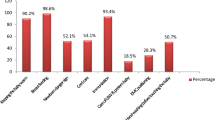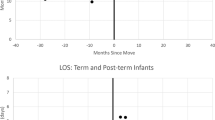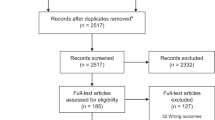Abstract
Objective:
To evaluate impact of simple interventions on neonatal mortality in a low-resource teaching hospital in India.
Study design:
Before-and-after intervention trial setting: limited resource teaching hospital; Design: Before and after study.
Interventions:
A package of simple interventions was evolved. The interventions included: rational admissions and early discharge, entrusting mothers in care-giving, enforcing asepsis routines, aggressive enteral feeding, abandoning unnecessary interventions, protocol-based management, rational antibiotics and training and empowerment of nurses.
Statistical methods:
The categorical and continuous variables were compared with χ2 and two-tailed tests, respectively.
Results:
Neonatal mortality rate declined significantly during the intervention period as compared to control period (20.3 versus 29.3 per 1000 live births; relative risk 0.69, 95% confidence interval (CI) 0.57 to 0.85). Most significant decline occurred in sepsis-related deaths. The survival of neonates with birth weight 1000 to 1499 improved over two folds (56.7% versus 24.5%, P<0.01). There was a significant decline in antibiotics use (635/878, 72.3% versus 299/897, 23.2%; P=0.00). The duration of stay in neonatal unit was decreased by a mean of 1.5 day (95% CI 0.9 to 2.8 days) after interventions.
Conclusions:
Simple interventions can result in a significant decline in neonatal mortality in hospitals with limited resources. This package is likely to be effective in hospitals with a high proportion of the sepsis deaths.
This is a preview of subscription content, access via your institution
Access options
Subscribe to this journal
Receive 12 print issues and online access
$259.00 per year
only $21.58 per issue
Buy this article
- Purchase on Springer Link
- Instant access to full article PDF
Prices may be subject to local taxes which are calculated during checkout

Similar content being viewed by others
References
Black RE, Morris SS, Bryce J . Where and why are 10 million children dying every year? Lancet 2003; 361: 2226–2234.
Paul VK . The current state of newborn health in low income countries and the way forward. Semin Fetal Neonatal Med 2006; 11: 7–14.
Lawn JE, Cousens S, Zupan J, Lancet Neonatal Survival Steering Team. 4 million neonatal deaths: when? Where Why? Lancet 2005; 365: 891–900.
Darmstadt GL, Bhutta ZA, Cousens S, Adam T, Walker N, de Bernis L, Lancet Neonatal Survival Steering Team. Evidence-based, cost-effective interventions: how many newborn babies can we save? Lancet 2005; 365: 977–988.
Knippenberg R, Lawn JE, Darmstadt GL, Begkoyian G, Fogstad H, Walelign N, Paul VK, Lancet Neonatal Survival Steering Team. Systematic scaling up of neonatal care in countries. Lancet 2005; 365: 1087–1098.
Deorari AK . Essential Newborn Nursing for Small Hospitals in Resource Restricted Countries – Learner's Guide. Department of Pediatrics, AIIMS: New Delhi, 2004.
Paul VK, Deorari AK, Bhutani VK . Protocols in Neonatology. Indian Journal of Pediatrics: New Delhi, 2005.
Aggarwal R, Agarwal R, Deorari AK, Paul VK . Retinopathy of prematurity. Indian J Pediatr 2002; 69: 83–86.
Singh M, Paul VK, Deorari AK, Ray D, Murali MV, Sundaram KR . Strategies which reduced sepsis-related neonatal mortality. Indian J Pediatr 1988; 55: 955–960.
Darmstadt GL, Nawshad Uddin Ahmed AS, Saha SK, Azad Chowdhury MA, Alam MA, Khatun M et al. Infection control practices reduce nosocomial infections and mortality in preterm infants in Bangladesh. J Perinatol 2005; 25: 331–335.
Stool BJ . Neonatal infections: a global perspective. In: Remington JS, Klein JO (eds). Infectious Diseases of the Fetus & Newborn Infants. 5th edn. WB Saunders Company: Philadelphia, 2001, pp 139–168.
National Neonatology Forum of India. National Neonatal Perinatal Database – Report for Year 2002–2003. NNF India: New Delhi, 2003.
Investigators of National Neonatal Perinatal Database Network of India. Morbidity and mortality among outborn neonates at 10 tertiary care institutions in India during the year 2000. J Trop Pediatr 2002; 48: 43–46.
English M, Esamai F, Wasunna A, Were F, Ogutu B, Wamal A et al. Assessment of inpatient pediatric care in first referral level hospitals in 13 districts in Kenya. Lancet 2004; 363: 1948–1953.
Chaturvedi P, Potdar S . Change in neonatal care pattern and neonatal mortality in a rural medical college. Indian Pediatr 1988; 25: 171–178.
Mantaring JB, Mandoza M, Estrada JM . Reduction in neonatal bacteremia and mortality using a simple set of interventions in a NICU in the Phillipines [abstract]. Infectious Diseases Society of America: Boston, 2004, p 80.
Zaidi AK, Huskins WC, Thaver D, Bhutta ZA, Abbas Z, Goldmann DA . Hospital-acquired neonatal infections in developing countries. Lancet 2005; 365: 1175–1188.
Sen A, Mahalanabis D, Singh AK, Som TK, Bandyopadhyay S . Development and effects of a neonatal care unit in rural India. Lancet 2005; 366: 27–28.
Bhutta ZA, Khan I, Salat S, Raza F, Ara H . Reducing length of stay in hospital for very low birthweight infants by involving mothers in a stepdown unit: an experience from Karachi (Pakistan). BMJ 2004; 329: 1151–1155.
Kumar M, Paul VK, Kapoor SK, Ananad K, Deorari AK . Neonatal outcomes at a subdistrict hospital in north India. J Trop Pediatr 2004; 50: 170–174.
Acknowledgements
We thank the nurses, resident doctors and the families of the neonates who were responsible for care of these neonates. We thank Professors Vinod Paul and Ashok Deorari of All India Institute of Medical Sciences, New Delhi for critical review of this paper and Drs Madhulika Allawadhi, Abhishek Kothari and K Kilnani for support to ROP screening program. We also thank Professor Adarsh Bhargava, Head, Department of Obstetrics and Gynecology, SMS Medical College for ongoing support and guidance.
Author information
Authors and Affiliations
Corresponding author
Rights and permissions
About this article
Cite this article
Agarwal, R., Agarwal, K., Acharya, U. et al. Impact of simple interventions on neonatal mortality in a low-resource teaching hospital in India. J Perinatol 27, 44–49 (2007). https://doi.org/10.1038/sj.jp.7211620
Received:
Revised:
Accepted:
Published:
Issue Date:
DOI: https://doi.org/10.1038/sj.jp.7211620
Keywords
This article is cited by
-
Feasibility, Sustainability, and Effectiveness of the Implementation of “Facility-Team-Driven” Approach for Improving the Quality of Newborn Care in South India
Indian Journal of Pediatrics (2023)
-
Causes of death in preterm neonates (<33 weeks) born in tertiary care hospitals in India: analysis of three large prospective multicentric cohorts
Journal of Perinatology (2019)
-
Quality improvement initiatives for hospitalised small and sick newborns in low- and middle-income countries: a systematic review
Implementation Science (2018)
-
Improved referral and survival of newborns after scaling up of intensive care in Suriname
BMC Pediatrics (2017)
-
Capacity building of nurses providing neonatal care in Rio de Janeiro, Brazil: methods for the POINTS of care project to enhance nursing education and reduce adverse neonatal outcomes
BMC Nursing (2012)



